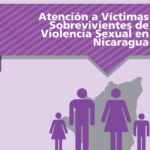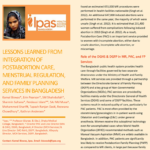Beatriz, a 22-year-old Salvadoran mother with lupus and kidney failure, is pregnant with an anencephalic fetus but continues to be denied a therapeutic abortion by the restrictive law in her country.

Esta publicación es un resumen de la norma y protocolo del Ministerio de Salud de Nicaragua sobre la violencia intrafamiliar y la violencia sexual, con un enfoque en el Protocolo para la Prevención, Detección, y Atención de la Violencia Sexual.

Lessons learned from integration of postabortion care, menstrual regulation, and family planning services in Bangladesh. This study recommended working toward improved post-procedure contraception delivery and evidence-based appropriate technology use for all procedures by improving collaboration and integration between Bangladesh’s Directorate General of Health Services (DGHS) and Directorate General of Family Planning (DGFP).
Understanding what factors influence the receipt of postabortion contraception can help improve comprehensive abortion care services. The abortion visit is an ideal time to reach women at the highest risk of unintended pregnancy with the most effective contraceptive methods. The objectives of this study were to estimate the relationship between the type of abortion provider (consultant physician, house officer, or midwife) and two separate outcomes: (1) the likelihood of adopting postabortion contraception; (2) postabortion contraceptors’ likelihood of receiving a long-acting and permanent versus a short-acting contraceptive method.
Two major women’s health organizations, Susan G. Komen for the Cure and Planned Parenthood, battled for women’s respect and donations. Two days later the dust is settling and we’re left to wonder what we should take away from the tangle? Was it about fundraising? Women’s health? Politics? I suggest it is about stigma, specifically abortion stigma that has been deliberately attached to a beloved national institution and household name, Planned Parenthood.
Unsafe abortion’s significant contribution to maternal mortality and morbidity was a critical factor leading to liberalization of Nepal’s restrictive abortion law in 2002. Careful, comprehensive planning among a range of multisectoral stakeholders, led by Nepal’s Ministry of Health and Population, enabled the country subsequently to introduce and scale-up safe abortion services in a remarkably short timeframe. This paper examines factors that contributed to rapid, successful implementation of legal abortion in this mountainous republic, including deliberate attention to the key areas of policy, health system capacity, equipment and supplies, and information dissemination.
At a time when the pool of abortion providers is shrinking and abortion clinics are closing, medical abortion can truly increase women’s access, particularly to those in underserved areas. For legislators who want to end access to abortion under any circumstances, medical abortion is an obvious target.
The new WHO recommendations make it painfully clear that, nearly 40 years after Roe v. Wade, we’re doing everything wrong here. Whether it’s gestational limits, ultrasounds, counseling or human rights, nearly every policy proposed by anti-abortion legislators directly contradicts the new WHO guidelines, which are based on years of consultation and discussion, incorporating scientific evidence and international human rights standards.
Unsafe termination of pregnancy is a major contributor to maternal morbidity and mortality. Task sharing termination of pregnancy services between physicians and mid-level providers, a heterogeneous group of trained healthcare providers, such as nurses, midwives and physician assistants, has become a key strategy to increase access to safe pregnancy termination care.
This study aimed to understand women’s pathways of seeking care for postabortion complications in Madhya Pradesh, India. The study recruited 786 women between July and November 2007.
Despite Zambia’s relatively progressive abortion law, women continue to seek unsafe, illegal abortions. Four domains of abortion attitudes – support for legalization, immorality, rights, and access to services – were measured in 4 communities.

